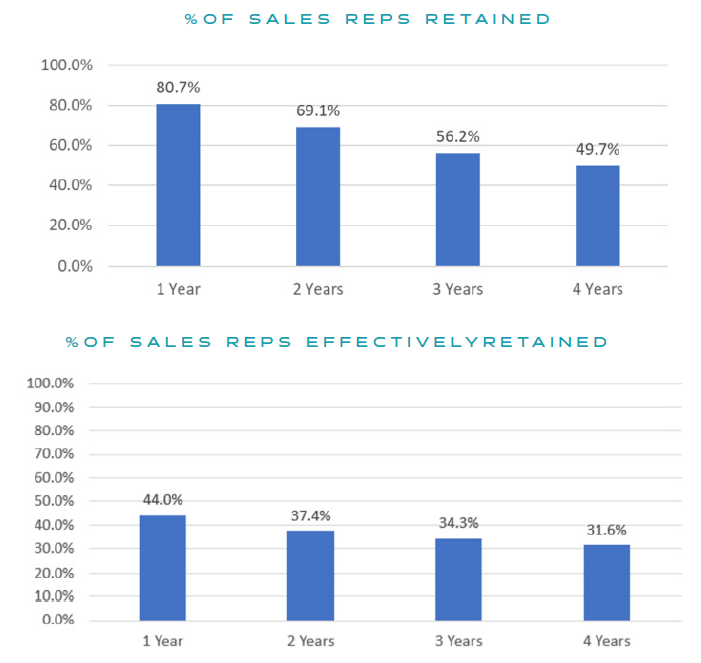The most important question to ask a potential pre-hire assessment provider or your in-house recruitment team is “Does the assessment predict future performance?” If the answer is yes, the next question is “Can you show me the statistical evidence or our latest predictive validation study?” From our experiences, the answer 99% of the time is “We do not have the evidence”. This statistical evidence is crucial; not only to protect your company from a legal challenge or from EEO discriminatory claims, but also for Corporate Growth and Corporate Wellness.
CORPORATE GROWTH
One of our competitors recently published an independent research study demonstrating their ability to increase retention without any mention of performance. It is easy to increase retention if you are not concerned with performance. Just simply hire dependable loyal individuals, create a country club atmosphere (e.g., employee rewards, no performance demands) and hire low potential candidates who have very few career options. You will have great retention, but inevitably a major performance issue. The key to corporate growth is to hire and retain top performers. This is referred to as EFFECTIVE RETENTION.
In a recent SMG study investigating 4 year rolling retention rates (i.e., if you hire 100 people today how many remain after 1,2,3, and 4 years), we found a major difference between overall retention and retaining the employees who are performing at an acceptable performance level. As evidenced, the effective retention is half the overall retention. In other words, the company is keeping half the employees who are not even performing at a minimal threshold.

To fix an effective retention issue often requires two concurrent strategies: attracting & converting more high potential candidates and retaining them. It is extremely frustrating and demanding for recruiters to continually meet growth demands when simultaneously having to rehire as a result of constant turnover. It is the classic double whammy created by organizations that hire anyone that applies without considering performance.
LEGAL PROTECTION
According to the primary principle of Equal Employment Opportunity (EEO) legislation, “every person regardless of attributes such as race, gender, religion, martial status, disability, language, age or sexual orientation, has an equal opportunity to find employment based on merit.” Consequently, anyone applying for a position at a company should have the same probability of succeeding if they have the characteristics associated with on-the-job performance.
Using non-job-related criteria can result in unfairly discriminating against candidates which is why it is recommended to use the most objective criteria possible. Some assessment providers attempt to use Content Validity to show the relationship between their test and job performance. This is useful information, but the gold standard requires conducting a Criterion Validity study that demonstrates the statistical ability of the assessment to predict future performance.
There are two types of criterion related validation: Concurrent and Predictive. Concurrent validation isgetting a client’s employee performance metrics, assessing the current employees then analyzing how effective the assessment was at predicting current performance. This is often step 1 of the validation process, which in reality it reflects a descriptive study that is similar to looking in the rear-view mirror. The real value in terms of helping a client make better hiring decisions is using an assessment to predict future performance and then tracking how effective the prediction model is working through yearly validation studies. Once it can be demonstrated the assessment can predict the future, the key is to ensure that it predicts accurately for all protected groups (the 80-20 rule) and that the client is proactively attempting to attract and hire inclusively.
CORPORATE WELLNESS
Hiring candidates that do not have the potential to perform at acceptable levels often results in a toxic work environment where top performers resent the corporate resources targeted to help poor performers. We have often seen in organizations, where more management time and training resources are dedicated to helping under-performing employees, while little time is spent with the high achievers. In exit interviews, this is one of the main reasons why companies have a challenging time retaining top performers.
Our studies also show that low potential and low performing employees feel incompetent and often become retention or burnout issues because they are using too much energy attempting to perform a job for which they are not naturally suited. SMG believes that the number one motivator of human performance is a sense of competence. If we think we do something well it will become self-reinforcing, if we feel incompetent, we will avoid it and it will be de-motivating. Success builds character not failure.
In conclusion, to be accountable and create an ROI for any pre-hire assessment it must predict both performance and effective retention. As mentioned, the first step is a concurrent benchmark study to assess and develop the customized predictive model to be implemented in the recruitment and selection process. The efficacy and ROI associated with this model is then evaluated with ongoing predictive validation studies.
SMG has been performing predictive studies for over 4 decades. If you are interested in how our research team can not only help you with the first step to protect you from Legal Challenges but assist with both Corporate Growth and Corporate Wellness please contact us at info@selfmgmt.com.

